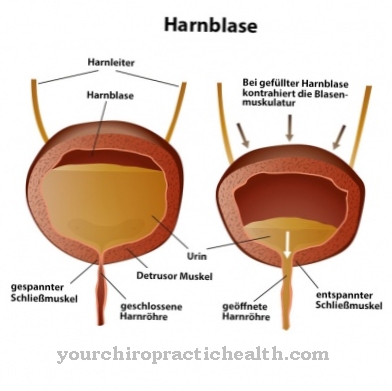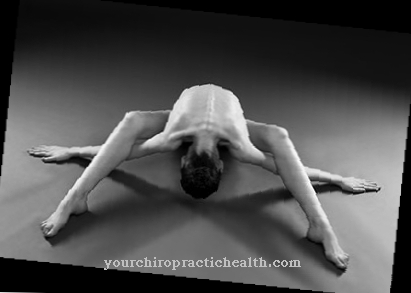A Fracture of the radial head is - with around 3 percent of all broken bones - a relatively rare fracture. The fracture occurs primarily as a result of a fall on the outstretched arm. In addition to the usual fractures, there are also complex fractures, which sometimes also cause accompanying injuries.
What is a fractured radial head?

© elina33 - stock.adobe.com
The Radial head fracture is divided into a total of five types. Type 1 is an unshifted fraction; this fracture is sometimes the most common form of this rare injury. In type 2, the doctor speaks of a displaced fracture, which is also called a chisel fracture, among other things. Type 2 is when there is a step formation that is more than 2 mm. Type 3 is the comminuted fracture. In type 4, the doctor speaks of a non-displaced radius neck fracture and in type 5 of a displaced radius neck fracture. Types 4 and 5 are classified according to the Bakalin special form.
causes
The most common or only cause of fracture of the radial head is falling on an extended or slightly bent arm. This means that indirect force is always the trigger for a fracture of the radial head. The fall causes a bony shear off, a straight fracture or can sometimes lead to a debris break (or a shattering of the radial head). There are no other known causes that could trigger a corresponding fracture.
Symptoms, ailments & signs
The patient complains of severe pain. The person concerned mainly describes the localization of the pain in the area of the forearm (near the radius) or near the elbow joint.
Many patients also complain of hand pain; here it can be assumed that the pain caused by the fracture of the radial head radiates into the hand. As the disease progresses, the mobility of the elbow joint is severely restricted. The fracture of the radial head also causes significant swelling - in the area of the elbow - which indicates an injury.
Diagnosis & course of disease
The doctor orders an X-ray examination. Using the imaging procedure, he can tell whether there is a fracture and what type it is. If the doctor cannot clearly see whether there has been any displacement of the bone, further examination methods (magnetic resonance therapy (MRI) or computed tomography) can provide information about the extent to which the radial head is injured.
These imaging procedures are also important in that any accompanying injuries can be excluded. Ultimately, the humerus or ulna could be injured. Depending on the type and accompanying injuries, the doctor decides whether conservative or surgical treatment or therapy is carried out. The healing time is around six weeks; Complications are usually not to be expected. Movement is not restricted after therapy; Consequential damage is not to be expected.
Complications
A fracture of the radial head can occasionally lead to complications. Doctors differentiate between earlier onset and later onset sequelae. Pseudarthrosis is regarded as a rather rare effect of fracture of the radial head. It is particularly evident in radial neck fractures that have not been sufficiently reduced.
Painful incorrect healing is possible as part of conservative therapy. This results in permanent misalignment or step formation. In the medium term, there is a risk of restricted movement when turning the forearm and post-traumatic osteoarthritis of the elbow. In such cases, operational measures are required.
One of the most common complications of a radial head fracture is a chronic restriction of movement of the elbow joint. Possible reasons for this are the fracture itself or too long a period of immobilization. Furthermore, stretch deficits in the forearm are possible, caused by capsule shrinkage or sticking. If the physiotherapeutic treatment does not bring any improvement, an operation can also help here.
Possible early onset sequelae of the radial head fracture are nerve injuries, the compartment syndrome or infections. Later complications can be infections or misalignments of the bones. An operation for the fracture of the radial head also carries the risk of complications.
In this way, adjacent structures can be affected during the procedure. These are mostly ligaments and nerves in the elbow region. In the worst case, there will be prolonged failure symptoms. Because an absolute success rate cannot be achieved with the help of surgical procedures, there is also the risk of osteoarthritis.
When should you go to the doctor?
A doctor should always be consulted immediately in the event of a fracture of the radial head. There is no self-healing, so the disease must definitely be treated by a doctor. This is the only way to avoid complications and ensure that they grow together properly after the fracture. A doctor should be consulted in the case of a fracture of the radial head if the patient suffers from very severe pain in the area of the forearm. A doctor should be consulted immediately, especially after a fall or any other injury in this area.
In an emergency, the emergency doctor should be called or the hospital should be visited. The pain can spread to the entire arm and have a very negative effect on the quality of life of the person concerned. As a rule, the mobility of the forearm is also significantly restricted by the fracture of the radial head. If the symptoms persist over a longer period of time, a doctor must be consulted. In most cases, an orthopedic surgeon can treat the fracture of the radial head well.
Therapy & Treatment
If the patient complains of severe pain or if there is severe effusion, the doctor can - using local anesthesia - perform a joint puncture at the beginning of the treatment. This largely relieves or alleviates pain.
After the swelling has subsided and the first results of the imaging tests are available, the doctor decides whether a conservative or surgical therapy and treatment should be chosen. If the doctor decides in favor of conservative therapy, the arm is immobilized first. This by means of an upper arm plaster splint. The upper arm or elbow is immobilized at an angle of 90 degrees.
If there is no postponed fracture, physiotherapy exercises can be started after a few days. After a few days, the person affected receives - instead of the plaster cast - a splint, which must be worn for around three weeks. After almost six weeks there is complete healing; freedom of movement should be fully restored - as before the accident. Physiotherapy exercises are recommended.
By means of these exercises, the movement of the joint is encouraged or the same possibility of movement is established as before the accident. Long-term effects are not to be expected - even if no physiotherapeutic exercises are used.
If conservative therapy is not possible, the doctor decides what type of operation is to be performed so that a perfect result can be achieved. A radius head resection is mainly performed. This surgical method is used, for example, for broken debris. If there is a complex or severe fracture, the doctor decides on a radial head prosthesis.
In this procedure, the injured radial head is replaced with a prosthesis. Here, too, the healing time is around six weeks; even after the operation, it is advantageous if any physiotherapeutic measures are taken so that complete freedom of movement is restored. There are - as a rule - no complications.
prevention
Ultimately, the fracture of the radial head cannot be prevented at all. It is important that the person concerned avoids falls or does not want to catch himself with outstretched arms. However, since this is a reflex action, it is almost impossible not to try to catch yourself with your hands in the event of a fall.
In elderly people or people who suffer from bone diseases (e.g. osteoporosis), fractures of the radial head can occur more frequently if they want to support themselves with their outstretched arms - as part of the fall. In this case, the probability of possible accompanying injuries increases.
Aftercare
The type and intensity of follow-up treatment for a fractured radial head depend on the conservative or surgical therapy used.Following conservative therapy with a splint, it is important to mobilize the elbow joint again as early as possible. This is to avoid permanent restrictions on movement.
The aim is to regain full mobility after about six weeks. If this works and there is no pain, no further follow-up treatment is required. In the case of surgical treatment of the radial head fracture, follow-up treatment begins seven to ten days after the elbow has been immobilized using a splint.
Follow-up care begins carefully with passive stretching exercises, i.e. without your own muscle strength. It is important to be patient while doing this, because a full extension of the elbow should not be achieved before four weeks have passed. The actual strength training to rebuild the muscles does not begin until eight to twelve weeks after the surgical treatment of the hernia.
If muscle training is started too early, the risk of permanent elbow restriction increases and should therefore be avoided. After achieving full mobility and rebuilding the muscles, no further follow-up treatment or check-up is necessary.
You can do that yourself
After a radial head fracture, accompanying measures such as rest and protection apply. Patients should cool any swellings and effusions and follow the doctor's instructions regarding physical exertion. The patient should speak to the doctor about natural pain relievers to support drug therapy. Physiotherapy, but yoga or Pilates exercises are also good ways to support recovery.
For the time being, those affected should not lift loads and should not stretch or bend their arm too much. In addition, the prescribed medication must be taken. Further measures focus on sparing the fracture and watching out for unusual symptoms. Since a fracture of the radius head is associated with restricted movement of the arm, aids such as crutches may be required.
If the fracture of the radius head occurred in the course of an accident, therapy may also be useful. Trauma and emotional problems must be clarified before serious mental illnesses such as depressive moods or fears develop from them. If the above measures are carried out consistently, the injury will quickly subside. However, should complications arise that cannot be alleviated by self-help measures, the doctor should be called in.



























